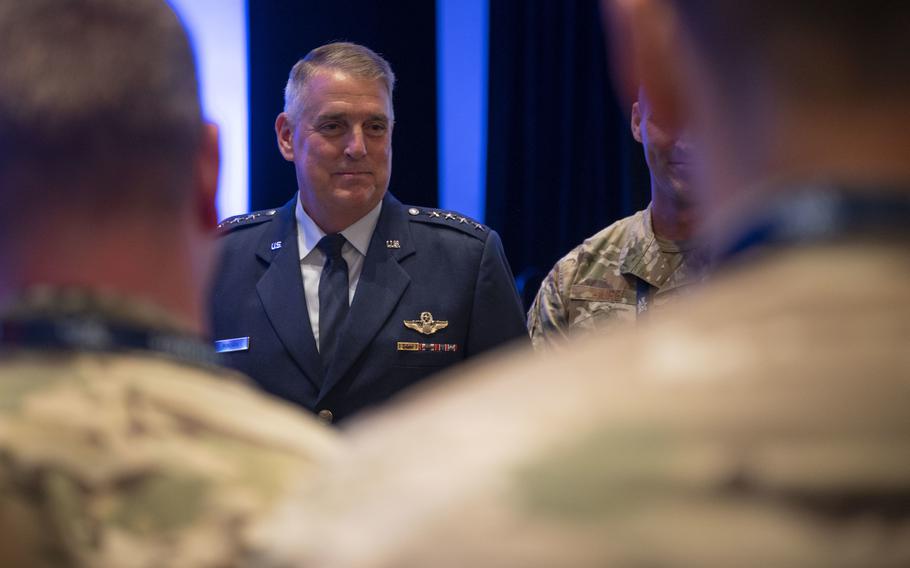
Gen. Mike Minihan, commander of Air Mobility Command, presents the Mobility Manifesto at the 2022 Air, Space & Cyber Conference in Oxon Hill, Md., Sept 21, 2022. During the speech he laid out the role of the mobility air forces in projecting, connecting, maneuvering and sustaining the joint force, as well as the consequences if mobility fails. (Zachary Boyer/U.S. Air Force)
Recently, the Air Force Association conference audience listened to Gen. Mike Minihan, head of Air Force Air Mobility Command, give a fiery speech defining his “Mobility Manifesto.” His emphasis was on the challenge of combat in the Western Pacific, and on the urgency to action required of Air Force personnel.
Minihan asked, “If my team were to walk into my office tomorrow and say ‘[The enemy] is getting ready to go,’ what am I going to do now? I’m going to take roll of who we’ve got, we’re going to take roll of the toys we have, and we’re going.”
It made me consider how he, and his people, would actually do that. In the event of a “near-peer” crisis, how would they actually figure out who is available to go, who is qualified to do what, who meets what requirements for “readiness,” where the needed personnel, supplies and equipment are, etc.? How will word get out to the right people, as they move about? How will key information get back to decision-makers, so they can act on it, as quickly as possible? How will that information flow change amid the evolving uncertainty and chaos of war?
I’m afraid the answer to all of those questions is “about the same way, in 2022, as it would have been done in 1992.”
The world of U.S. “defense innovation” likes shiny things, buzzy things — artificial intelligence and machine learning, hypersonics and autonomous vehicles. No doubt these are critical. They also tend to come with phrases like “give us 10 years and a billion dollars, and we will get there.” Speed to impact means reducing that timeline to seven years, or, aggressively, five years.
But, the capabilities needed to answer Minihan’s question — and my follow-on ones — are different. They don’t require massive, up-front investments, nor many years before any value is seen. What they require is the shift that the commercial world made many years ago — that is, one away from operating via stacks of paper and dusty hardwired desktop computers, and toward leveraging the digital capabilities that are already in our pockets. That shift can, and should, come immediately. It will pay dividends immediately.
The military needs mobile software tools. They will bring critical operational speed to defense organizations.
This is the reason why, when the chief of Navy Reserve, Adm. John Mustin, sponsored the “i3 Waypoints” event to solicit improvement ideas from across his force, the “winning pitch” was “Leveraging Mobile Technology to Streamline Mobilization.” The idea was to enable reservists to securely use their mobile phones to get critical work — in particular, that needed to rapidly mobilize for war — done. Military jobs are inherently mobile ones. Personnel don’t typically sit at a computer desk all day to conduct their work — they are in the field, on flight lines, on ships, etc.
An outsider would ask, “Doesn’t the military already use mobile?” After all, we use our phones to manage most things in our personal lives, and the commercial world long ago adopted mobile software applications to accomplish core processes more effectively and efficiently. But the answer is no. Military members are overwhelmingly not able to use their phones in any structured and secure way to get important things done.
So how do military units execute core business processes — things like the dissemination of critical information, collection of data, documentation of training, on-the-fly coordination of teams and requirements? They run phone trees. They pass around clipboards. They use pieces of paper stuffed into flight suit pockets. They collect data in little green notebooks. They place magnets on whiteboards.
At the same time, leaders need data visibility in order to make decisions. So, all of that disparate and disorganized written information gets manually entered into some archaic desktop system, or into a cobbled-together Excel tracker, over many painstaking person-hours, each day.
Generals and admirals love the “quad-slide” — a PowerPoint slide of four parts, with which they can see all information needed for a decision. But, how many dozens of hours of wrangling were required to collect the data shown? How time-late is the data? How accurate is it, given all the manual transposing and manipulation? When you need to get critical information to and from personnel fast, then orchestrate dynamic actions, the right tools are not in place. These capability gaps are foundational, and they need addressing now.
The rest of the U.S. military needs to take a cue from Minihan’s call to action, and from the Navy Reserve innovation selection. Urgency is imperative.
Want to move fast to get to real operational impact? Put something useful in the hands of your people, something they can leverage for impact today, from wherever they operate.
Military service members need mobile capabilities now.
Jeff Prosek served 10 years as a naval aviation flight officer. He is head of strategy at Adyton, a veteran-led startup that was selected by the Air Force innovation team for multiple contracts leveraging its secure mobile software, and by other units across DOD for production scaling of impact for those who serve.